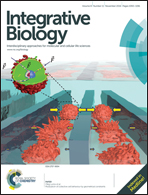A multiphysics model of the Pacinian corpuscle
Abstract
The Pacinian corpuscle (PC) is a dermal mechanoreceptor that responds to high-frequency (20–1000 Hz) vibrations. The PC's structure allows transmission of vibrations through its layers (lamellae) to the centrally-located nerve fiber (neurite). This work combines mechanical models of the PC with an electrochemical model of peripheral nerves to simulate the tactile response of the entire system. A three-stage model of response to a vibratory input was developed, consisting of (1) outer core mechanics, (2) inner core mechanics, and (3) neurite electrochemistry. The model correctly predicts the band-pass nature of the PC's frequency response, showing that the PC structure can amplify oscillatory strains within its target frequency band. Specifically, strain induced by a vibratory stimulus is amplified by a factor of 8–12 from the PC surface to the neurite. Our results also support the hypothesis that PC rapid adaptation is affected by the lamellar structures without requiring neuronal adaptivity. Simulated different-sized PCs showed a shift in frequency response, suggesting that clusters of different-sized PCs could enable more nuanced tactile encoding than uniform clusters. By modeling the PC's mechano-to-neural transduction, we can begin to characterize the mechanosensation of other receptors to understand how multiple receptors interact to create our sensation of touch.



 Please wait while we load your content...
Please wait while we load your content...